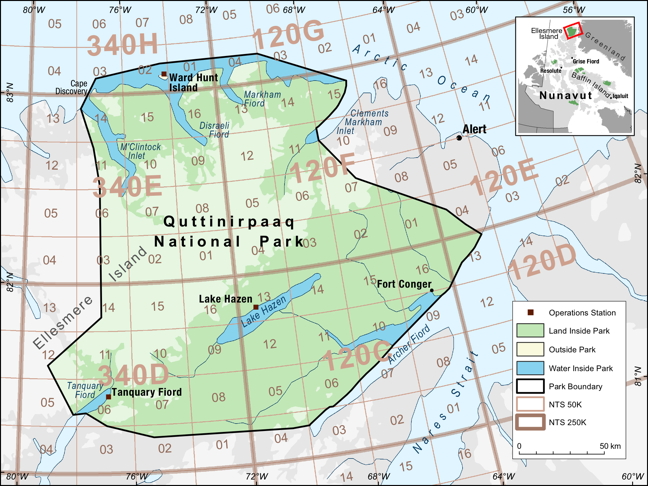Nunavut park gets makeover, approval of huge fuel cache
Quttinirpaaq National Park base can store up to 160,000 litres of aviation fuel

Tanquary Fiord’s environment in the southwest corner of Quttinirpaaq National Park on Ellesmere Island. The fuel storage is located at the end of the airstrip. (PARKS CANADA IMAGE)

A map of Quttinirpaaq National Park, located on the northern tip of Ellesmere Island. (PARKS CANADA MAP)
Parks Canada will make some big changes at its most northerly and remote park this summer including renovating and expanding facilities and greatly increasing the amount of aviation fuel stored on site.
Both projects, in Quttinirpaaq National Park on Ellesmere Island, recently gained approval from the Nunavut Impact Review Board.
The first project involves upgrading facilities at Tanquary Fiord, the park’s main base camp, which includes a visitor’s centre, shelter and accommodations for staff and visitors, storage facilities and an airstrip.
The Tanquary Fiord base, located at the southwest corner of the park, was established by the Department of National Defence in 1963.
The Quttinirpaaq project also involves upgrades to fuel storage facilities at Lake Hazen and Ward Hunt Island.
Upgrades at Tanquary Fiord are meant to “enhance visitors’ experience to the park, reduce environmental impacts of operations, as well as create opportunities for additional benefits to the people through local contracting options, employment opportunities and increased tourism,” according to the project description.
Those upgrades include:
• converting the current visitor centre into four private accommodations rooms for visitors;
• building a change room and shower stall with “solar-style water bag” and grey water system for visitors to wash up;
• renovating the staff kitchen;
• reviewing the solar electrical system to make it more efficient, reliable and easier to use;
• installing a fuel containment berm and cover in fuel storage area; and,
• relocating an emergency shelter to a more accessible location for visitors.
These upgrades, part of a multi-year program, are expected to be completed by the end of August.
Quttinirpaaq, which means “Land at the Top of the World,” is located on Ellesmere in Canada’s High Arctic, north of the listening station at Eureka and south of the Canadian military base at Alert.
Full of ice-capped mountains, glaciers and sparse tundra, Quttinirpaaq, first named a national park reserve in 1988, became a national park in 2000.
Because of its airstrip and its location as the jumping off base for various territorial and federal projects — including those under the DND and the Polar Continental Shelf Project — Parks Canada is under increasing pressure to store greater amounts of aviation fuel at Tanquary Fiord to support flights to more remote regions.
These external projects include research on lakes, climate, landscape evolution, ecology and hydrology, explained Bronwyn Pavey, Parks Canada spokesperson, in a July 15 email.
Parks Canada decided it would make an exception to its parks policy and allow large caches of fuel at Tanquary Fiord, roughly 600 kms north of Grise Fiord, and on July 7, the NIRB gave approval, stipulating that Parks Canada impose strict environmental controls.
According to the NIRB screening report, Class B Territorial Land Use Permits allow for the storage of 80,000 litres of aviation fuel, typically contained in 45-gallon drums.
Parks Canada now has approval to store 160,000 litres of aviation fuel at Tanquary Fiord and has implemented a new fuel cache protocol and spill response plan that requires Parks Canada, and other clients who store fuel there, to follow some new guidelines including:
• mandatory use of secondary containment for all fuel drums;
• drums stored during camp closure must be covered;
• mandatory provision of on-site spill kit by each organization storing fuel;
• no stockpiling — fuel not used within three years must be removed;
• empty or damaged barrels must be removed; and,
• annual end of season inspection reports of caches to be undertaken by organization storing fuel and submitted to Parks Canada.
While wolves, muskoxen, Arctic hares, shorebirds, Peary caribou and polar bears have been known to frequent the area, Parks Canada does not believe the fuel storage will impact them.





(0) Comments